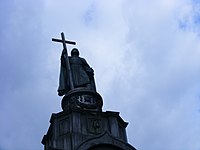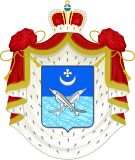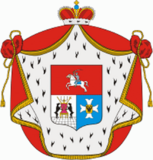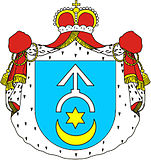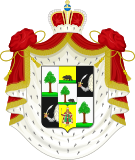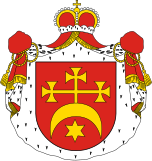Rurikids
This article should specify the language of its non-English content, using {{lang}}, {{transliteration}} for transliterated languages, and {{IPA}} for phonetic transcriptions, with an appropriate ISO 639 code. Wikipedia's multilingual support templates may also be used. (July 2019) |
The Rurik dynasty,
The Romanovichi ruled the southwestern territories, which were unified by
As a ruling house, the Rurikids held their own for a total of 21 generations in male-line succession, from Rurik (d. 879) to Feodor I of Russia (d. 1598), a period of more than 700 years.[14][15] Numerous princely families have claimed to trace their lineage to Rurik. They are one of Europe's oldest royal houses, with numerous existing cadet branches.
Origins
Genealogical issues
The origins of the Rurikids are unclear, as its namesake
Ethnographic issues
The scholarly consensus[28] is that the Rus' people originated in what is currently coastal eastern Sweden around the eighth century and that their name has the same origin as Roslagen in Sweden (with the older name being Roden).[29][30][31]
According to the prevalent theory, the name Rus', like the Proto-Finnic name for Sweden (*Ruotsi), is derived from an Old Norse term for "the men who row" (rods-) as rowing was the main method of navigating the rivers of Eastern Europe, and that it could be linked to the Swedish coastal area of Roslagen (Rus-law) or Roden, as it was known in earlier times.[32][33] The name Rus' would then have the same origin as the Finnish and Estonian names for Sweden: Ruotsi and Rootsi.[33][34]
The Primary Chronicle gives the following account the "Calling of the Varangians", dating it to the Byzantine years of the world 6368–6370 (AD 860–862):[35]
The tributaries of the
Truvor, in Izborsk. On account of these Varangians, the district of Novgorod became known as the land of Rus'. The present inhabitants of Novgorod are descended from the Varangian race, but aforetime they were Slavs [преже бо бѣша Словѣни].
There is some ambiguity even in the Primary Chronicle about the specifics of the story, "hence their paradoxical statement 'the people of Novgorod are of Varangian stock, for formerly they were Slovenes.'" However, archaeological evidence such as "Frankish swords, a sword chape and a tortoiseshell brooch" in the area suggest that there was, in fact, a Scandinavian population during the tenth century at the latest.[36]
Genetic studies
A genetic study on the origins of Rurikids (Zhur et al. 2023) analysed "for the first time", remains belonging to Prince
History

Rurik and his brothers founded a state that later historians called Kievan Rus′. By the middle of the twelfth century, Kievan Rus′ had dissolved into independent
Vsevolod's line eventually became better known as the Monomakhovichi and was the predominant one. The line of Sviatoslav later became known as Olegovychi and often laid claim to the lands of Chernihiv and Severia. The Izyaslavychi who ruled Turov and Volhynia were eventually replaced by a Monomakhovychi branch.[citation needed]
According to Jaroslav Pelenski,
The 'Riurikide' dynasty and the ruling elite ... attempted to impose on their highly diverse polity the integrative concept of russkaia zemlia ('the Rus' land') and the unifying notion of a 'Rus' people'. ... But 'Kievan Rus'' was never really a unified polity. It was a loosely bound, ill-defined, and heterogeneous conglomeration of lands and cities inhabited by tribes and population groups whose loyalties were primarily territorial.[39]
This caused the Rurikid house to effectively dissolve into several sub-dynasties ruling smaller states in the 10th and 11th centuries. These were the Olgoviches of
Descendants of Sviatoslav II of Kiev
The Olgoviches descended from
Descendants of Vsevolod I of Kiev
Vsevolod I of Kiev was the father of Vladimir II Monomakh, giving rise to the name Monomakh for his progeny. Two of Vladimir II's sons were Mstislav I of Kiev and Yuri Dolgorukiy.
The Romanoviches (Izyaslavichi of Volhynia) were the line of
The Rostislaviches were the line of Rostislav I of Kiev, another son of Mstislav I of Kiev, who was Prince of Smolensk and a progenitor of the lines descending from the princes of Smolensk and Yaroslavl.[citation needed]
The Shakhovskoys were founded by Konstantin "Shakh" Glebovich, Prince of Yaroslavl, and traces its lineage to Rostislav I of Kiev through his son Davyd Rostislavich. This branch also descends cognatically of Ivan I of Moscow, through the latter's daughter Evdokia Ivanovna Moskovskaya (1314–1342),[41][full citation needed] who married Vasili Mikhailovich, Prince of Yaroslavl (died 1345).[42] They were the great-grandparents of Andrey and Yuriy, the first Shakhovskoy princes. This is possibly the most senior extant branch of the Rurikids, with many Shakhovskoys living outside of Russia after having fled during the Russian Revolution.[citation needed]
The Yuryeviches were founded by
Vsevolod's son Yaroslav II of Vladimir was the father of Alexander Nevsky, whose son Daniel of Moscow sired the ruling house of Moscow until the end of the 16th century; the princes of Moscow are often referred to as the Daniilovichi.[6]
Beginning with the reign of
In that year,
Branches
This section needs additional citations for verification. (May 2023) |
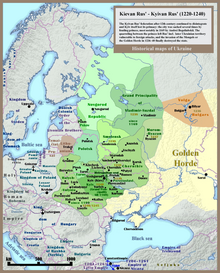
- Izyaslavichi of Polotsk, princes of Polotsk
- Putyatin, princes Putyatin (extant)
- Izyaslavichi of Turov, princes of Turiv and Volhynia
- Monomakhovichi, princes of Pereyaslav
- Izyaslavichi of Volhynia, princes of Volhynia, kings of Rus (senior branch)
- Rostislavichi of Smolensk, princes of Smolensk (middle branch)
- Kropotkin, princes Kropotkin (extant)
- Lvov princely family, emerged in the 17th century as descendants of the Rostislavichi princes of Yaroslavl (before 1260 Yaroslavl was in Yurievichi hands)
- Rzhesvsky, non-titled (extant)
- Prozorovsky (extinct since 1914)
- Yurievichi, princes of Vladimir-Suzdal; until 1260 princes of Yaroslavl
- Muscovy and the Tsardom of Russia until it went extinct with the 1598 death of Feodor I, which caused the Time of Troubles.
- Konstantinovichi, princes of Galich, Russia (1247–1362). Progenitor: Konstantin Yaroslavich, son of Yaroslav II of Vladimir
- Lyapunov family, emerged in the 16th century as descendants from the Konstantinovichi princes of Galich, Russia
- Shakhovskoy, princes of Yaroslavl (senior extant branch)
- Lobanov-Rostovsky, princes of Rostov (middle extant branch)
- Gagarin, princes of Starodub-on-the-Klyazma (junior extant branch)
- Khilkov, princes of Starodub-on-the-Klyazma (junior extant branch)
- Sviatoslavichi, princes of Ryazan and Murom
- Olgovichi, princes of Chernihiv
- Belarusian nobles
- Gorchakov, princes Gorchakov (extant)
- Massalski family, princes of Mosalsky (Massalsky)
- Obolensky, princes Obolensky (extant)
- Dolgorukov, princes Dolgorukov (extant; cadet branch of the Obolensky family)
- Rostislavichi of Tmutarakan, princes of Tmutarakan
- Rostislavichi of Halych, princes of Halych
- Vadbosky, a branch of the princes Belozersky (extant)
- Volkonsky, a branch of the princes of Tarusa (extant)
Disputed
- Possibly the Ogiński family; various "Rurikid" branches have been proposed, as well as Lithuanian ones.[citation needed]
- Possibly the Romanovichi, but could also be descended from the Lithuanian Gediminids.[citation needed]
- Possibly the Wiśniowiecki family, a branch of the House of Zbaraski (extinct),[47] but could also be descended from the Lithuanian Gediminids.[citation needed]
Legacy
The predominant Ukrainian view had gradually changed over time. After decline of Kievan Rus rulers of Galicia-Volhynia claimed sole succession and the title of ruler of all former Rus lands as was noted in
During Soviet times by 1930s prior All-Russian nation ideology was a modified to "allot equal rights to the Kievan inheritance to the Three Slavic peoples, that is the Russians, the Ukrainians, and the Belorussians", but later elevated the Russian nation as the elder brother to give the others "needed guidance in revolutionary struggles and socialist construction."[51]
There are currently various extant branches of the Rurikids, for instance: the Houses of
Gallery
-
Arms of the House ofHolstein-Gottorp-Romanov
-
Coat of arms of theDolgorukyfamily
-
Coat of arms of the Belosselsky-Belozersky family
-
Coat of arms of the Kropotkin family
-
KhilkoffCoat of arms
-
Coat of arms of theGolitsynfamily
-
Coat of arms of the Gorchakov family
-
Coat of arms of the Mosalsky family
-
Coat of arms of theOstrogskifamily
-
TheChernigov.
-
Coat of arms of the Romodanowski family
-
Coat of arms of theShuyskifamily
-
Coat of arms of theTatischevfamily
See also
Notes
- ^ Belarusian: Рурыкавічы, romanized: Rurykavichy; Russian: Рюриковичи, romanized: Ryurikovichi, Ukrainian: Рюриковичі, romanized: Riurykovychi, lit. 'sons/scions of Rurik'.
- ^ Christian Raffensperger (2012, 2017), Ostrowski (2018), Halperin (2022).[16][17]
- ^ Including Hrushevsky (1904), Vernadsky (1943), Riasanovsky (1947), Paszkiewicz (1954), Franklin and Shepard (1996).[20]
- ^ 'Of the eighteen cases of a new ruler ascending to the throne, the [Kievan Chronicle] describes their sitting on the throne of their "grandfather and father" 15 times, 18 of their "grandfathers and fathers" twice, and of his "father and grandfathers" once.'[22] The two 5-generation lists in the Kievan Chronicle includes the 12th-century Rurik Rostislavich, but no mention of the supposed dynasty founder Rurik, which Ostrowski (2018) found remarkable: '[The Kievan Chronicle] makes no reference, allusion, or mention in any way to the Riurik who supposedly founded the dynasty, even more telling because of the ruler who he is extolling has the same name. When a connection with Riurik could be made with the addition of just one more generational antecedent, we find no attempt to do so before the mid fifteenth century.'[23]
References
- ^ a b Ostrowski 2018, p. 30.
- ^ Rurik Dynasty (medieval Russian rulers) Archived 27 March 2015 at the Wayback Machine Britannica Online Encyclopedia
- ISBN 9780192854346.
- ISBN 1107639425.
- doi:10.17223/18572685/36/8 (inactive 31 January 2024). Archived (PDF) from the original on 26 June 2022. Retrieved 23 May 2022.)
{{cite journal}}: Cite journal requires|journal=(help)CS1 maint: DOI inactive as of January 2024 (link - ^ ISBN 978-1-4008-3470-9. Archivedfrom the original on 3 November 2023. Retrieved 30 October 2023.
The Moscow princes are often called Daniilovichi after their most prominent ancestor, Daniil, Alexander Nevskii's son
- ASIN B004GV3YAM.
- ^ May, T. "Khanate of the Golden Horde". accd.edu. Archived from the original on 7 June 2008. Retrieved 27 December 2007.
- ISBN 978-0-19-534814-9. Archivedfrom the original on 3 November 2023. Retrieved 30 October 2023.
- ISBN 9781438108292. Archivedfrom the original on 3 November 2023. Retrieved 5 October 2023.
- ISBN 9780815412298.
- from the original on 1 October 2023. Retrieved 5 October 2023.
- ^ "Rurik Dynasty Lays Claim to Kremlin". The Moscow Times. 16 June 2010. Archived from the original on 26 November 2022. Retrieved 24 October 2022.
- ^ Christian Raffensperger and Norman W. Ingham, "Rurik and the First Rurikids", The American Genealogist, 82 (2007), 1–13, 111–119.
- ISBN 978-0-674-01193-9. Archivedfrom the original on 3 November 2023. Retrieved 30 October 2023.
Thus the dynasty that had ruled Rus' for over 700 years-the Riurikid-ended. Boris Godunov was "elected" tsar, but his legitimacy was challenged
- ^ a b Halperin 2022, p. viii.
- ^ Ostrowski 2018, p. 47.
- ^ Ostrowski 2018, p. 39.
- ^ Ostrowski 2018, p. 35.
- ^ Ostrowski 2018, p. 30–31, 39.
- ^ Ostrowski 2018, p. 32–34.
- ^ Ostrowski 2018, p. 34.
- ^ Ostrowski 2018, p. 35–36.
- ^ a b c Ostrowski 2018, p. 30–31.
- ^ Ostrowski 2018, p. 36.
- ^ Ostrowski 2018, p. 31.
- ^ Raffensperger 2016, p. 9.
- ^ "The Vikings at home". HistoryExtra. Archived from the original on 4 May 2020. Retrieved 24 May 2020.
- ^ "Kievan Rus". World History Encyclopedia. Archived from the original on 14 April 2021. Retrieved 24 May 2020.
- ^ "The Vikings (780–1100)". metmuseum.org. Archived from the original on 23 April 2020. Retrieved 24 May 2020.
- ^ "Viking Tours Stockholm, 20 Historical Cultural Transported Tours". Sweden History Tours. Archived from the original on 19 May 2020. Retrieved 24 May 2020.
- ISBN 9780521035521. Archivedfrom the original on 14 April 2023. Retrieved 28 March 2020.
- ^ a b Stefan Brink, 'Who were the Vikings?', in The Viking World Archived 14 April 2023 at the Wayback Machine, ed. by Stefan Brink and Neil Price (Abingdon: Routledge, 2008), pp. 4–10 (pp. 6–7).
- ^ "Russ, adj. and n." OED Online, Oxford University Press, June 2018, www.oed.com/view/Entry/169069. Retrieved 12 January 2021.
- ^ The Russian Primary Chronicle, translated by Samuel Hazzard Cross and Olgerd Sherbowitz-Wetzor, pp. 59–60. For original, see here Archived 16 September 2017 at the Wayback Machine.
- ^ Franklin, Simon, and Jonathan Shepherd. The Emergence of Rus 750–1200. Harlow, Essex: Longman Group, Ltd., 1996. pp. 38–39.
- PMID 37908771.
Genome-wide data of the medieval and modern Rurikids unequivocally indicates that they belong to the N1a haplogroup of the Y chromosome...the contribution of three ancestral components to his origin: (1) the early medieval population of the east of Scandinavia from the island of Oland, (2) representatives of the steppe nomadic peoples of the Eurasian steppes of the Iron Age or the early medieval population of central Europe (steppe nomads from the territory of Hungary), and (3) the ancient East-Eurasian component....Previously, using these samples as an example, the gene flow of the peoples of Siberia (East Eurasian component) to the North and East of Europe was shown [34]. A high degree of homology in the Y chromosome of a representative of the Russian noble family and people of the early metal era led us to the hypothesis of the possible contribution of the East Eurasian gene pool to the formation of the northern European population of the early Middle Ages.
- ISSN 2707-000X.
- ^ a b Pelenski, Jaroslaw. The Contest for the Legacy of Kievan Rus. New York: Columbia University Press, 1998. p. 4
- ^ Raffensperger, Christian, and Norman W. Ingham, "Rurik and the First Rurikids", The American Genealogist, 82 (2007), 1–13, 111–119.
- ^ Averyanov K. Principality of Moscow under Ivan Kalita (Accession of Koloman. Acquisition of Mozhaisk). – M., p. 36, 1994.
- ISBN 978-5-7429-0350-5.
- Russia Today (in Russian). Archivedfrom the original on 28 March 2022. Retrieved 17 March 2022.
- ^ Martin 2004, p. 428.
- ^ "Скаржинські". Archived from the original on 19 April 2023. Retrieved 6 August 2023.
- ^ "FamilyTreeDNA - Russian Nobility DNA Project". Archived from the original on 6 August 2023. Retrieved 6 August 2023.
- ISBN 978-0-313-26007-0. Archivedfrom the original on 27 April 2023. Retrieved 12 November 2020.
- ^ a b Pelenski, Jaroslaw Pelenski (1998). The Contest for the Legacy of Kievan Rus' Archived 27 February 2022 at the Wayback Machine. New York: Columbia University Press.
- ^ Горовенко А. В. Меч Романа Галицкого. Князь Роман мстиславич в истории, эпосе и легендах. — Спб.: «Дмитрий Буланин», 2011. С. 154.
- ^ Дмитриев М. В. Этнонациональные отношения русских и украинцев в свете новейших исследований // Вопросы истории, № 8. 2002. — С. 154—159
- Wikidata Q106457257
- ^ Manaev, G. (8 July 2019). "Who founded Russia and ruled it before the Romanovs". Russia Beyond the Headlines. Archived from the original on 14 January 2020. Retrieved 29 January 2020.
Bibliography
- Halperin, Charles J. (2022). The Rise and Demise of the Myth of the Rus' Land (PDF). Leeds: Arc Humanities Press. p. 107. ISBN 9781802700565. Retrieved 1 February 2023.
- Martin, Janet (2004) [1995]. Medieval Russia: 980–1584. Cambridge: Cambridge University Press. ISBN 9780521368322.
- Ostrowski, Donald (2018). "Was There a Riurikid Dynasty in Early Rus'?". Canadian-American Slavic Studies. 52 (1): 30–49. .
- Raffensperger, Christian (2016). Ties of Kinship: Genealogy and Dynastic Marriage in Kyivan Rus'. Cambridge, Massachusetts: Harvard Ukrainian Research Institute. p. 418. ISBN 9781932650136.


